Define and Frame Your Design Challenge by Creating Your Point Of View and Ask “How Might We”
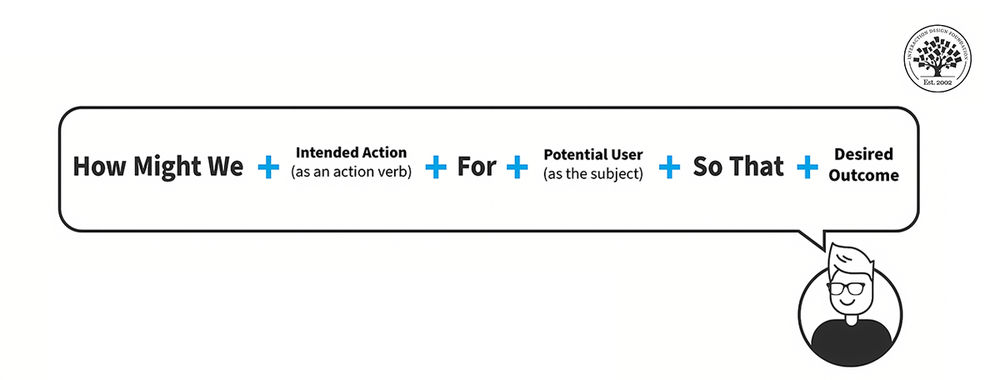
- 1.2k shares
- 5 years ago
How Might We (HMW) is a design thinking method that allows designers to reframe and open up their problem statements for efficient, targeted and innovative ideation sessions to help solve design challenges. HMW is the bridge between the Define and Ideate stages of the design thinking process.
“The ‘how’ part assumes there are solutions out there — it provides creative confidence…‘Might’ says we can put ideas out there that might work or might not — either way, it’s OK. And the ‘we’ part says we’re going to do it together and build on each other’s ideas.”
– Tim Brown, IDEO Chairman and former CEO
Write effective How Might We questions with a structured approach. Use the formula below and follow the steps to create effective HMW questions.
Follow this helpful HMW formula to get started in your ideation session: “How might we” + Intended Action (as an action verb) + “for” + Potential User (as the subject) + “so that” + Desired Outcome. For example, “How might we provide healthier meals (intended action) for teenagers (potential users) so that they stay away from junk food (desired outcome).
© Interaction Design Foundation, CC BY-SA 4.0
For example, here is a hypothetical problem statement:
“University students need to save as much money as possible when buying their textbooks for their courses because it’s a big expense for them each academic year and they don’t have a lot of disposable income.”
HMW questions could include:
“How might we help students connect with each other so that they can buy and sell their textbooks from each other at discounted prices?”
Or
“How might we collaborate with local bookstores to facilitate the purchase and sale of low-cost university textbooks on and off campus?”
Step 1: Clearly define the problem or challenge with a concise problem statement to capture the core of the problem. This sets the foundation for HMW questions.
Step 2: Break down the problem statement into its key components.
Step 3: Choose an action verb that prompts action and exploration.
Step 4: Insert the subject relevant to the challenge or problem.
Step 5: Add a provocative element to encourage creative and fresh thinking.
Step 6: Generate several HMW questions by varying the action verbs, subjects, and provocative elements.
Step 7: Review and prioritize the HMW questions based on their relevance and potential impact. Refine the language for clarity.
Step 8: Test HMW questions within the design team or with stakeholders. Iterate based on feedback and insights—explore variations of HMW questions, such as "In what ways might we..." or other creative prompts.
Step 9: Develop follow-up questions to deepen understanding and guide the ideation process.
Step 10: Creating effective HMW questions is an iterative process. Repeat the steps as needed. Refine and edit the HMWs based on insights gained during the process.
The goal is to prompt innovative thinking and inspire a range of potential solutions. Adjust the formula and steps based on the specific context and nature of the design challenge.
In the context of sustainable practices: A rural community struggles with the environmental impact of single-use plastic, and there’s a need to find sustainable alternatives.
Problem statement: A village community needs to decrease their use of single-use plastics and find better alternatives because it negatively impacts their environment.
HMW questions:
How might we encourage community members to adopt reusable alternatives for everyday items like bags and containers?
How might we collaborate with local businesses to reduce the use of single-use plastic in packaging?
How might we make sustainable alternatives more accessible and affordable for a diverse range of community members?
Variations of HMW questions:
What's stopping us from implementing a community-wide education campaign on the environmental consequences of single-use plastic?
What would happen if we introduced incentives for businesses and individuals to actively participate in plastic recycling initiatives?
In what ways might community members be motivated to participate in a neighborhood clean-up event focused on plastic waste?
What has changed in consumer behavior that allows us to explore new, eco-friendly packaging solutions for local products?
Who needs to be involved in creating and implementing local policies to encourage the reduction of single-use plastic?
When should we launch awareness campaigns to coincide with significant community events and maximize impact?
These HMW questions address various aspects of the community's relationship with single-use plastic and explore education, incentives, collaboration, policy and the broader context of sustainability. They guide initiatives that contribute to the reduction of plastic waste and foster a more environmentally friendly community.
“When you let your mind wander across the blank page of possibilities, all constraints and preconceptions disappear, leaving only the trace of a barely glimpsed dream, the merest hint of a sketch of an idea.”
– Marty Neumeier's second rule of genius from The 46 Rules of Genius: An innovator’s guide to creativity
To better understand the concept of HMWs and expand on the approach, refer to Marty Neumeier's second Rule of Genius for inspiration. The rule refines the HMW generation process and helps designers express desires for potential users. Use alternative HMW question formulations like:
"In what ways might we…?" (Allow for multiple solutions.)
"What's stopping us from...?"
"What would happen if...?"
After, ask follow-up questions such as:
"Why would we...?"
"What has changed to enable us to...?"
"Who would need to...?"
"When should we...?"
Additionally, it is useful to incorporate a "Why wouldn’t we…?" question to uncover potential adverse consequences of specific design decisions, but designers can complete this at a later stage in the process.
Design teams formulate HMWs from clear problem statements, then dig deeper by splitting the problem into smaller, actionable HMW questions. It’s an iterative process, resulting in multiple possible solutions.
© Interaction Design Foundation, CC BY-SA 4.0
The guide below consists of key points to follow to craft effective HMW questions. At the end of this section, download a convenient IxDF template to help create optimal HMW questions based on the recommended practices:
Ensure a Clear and Concise Problem Statement: To make "How Might We" questions meaningful, it is imperative to have a clearly defined problem statement. Within the problem statement, frame a clear vision or goal that strikes the right balance—neither too narrow nor overly broad.
Always Start with the Problem Statement: Incorporate the problem statement into the HMW questions so the HMWs directly relate to the problem at hand. For example, rewrite the problem statement with “How might we…” at the beginning, and iterate as needed.
Split the Problem Statement into Multiple HMWs: Explore the design challenge further by breaking it down into smaller, relevant questions. Five to ten HMW questions for one problem statement serve as a solid foundation.
Prioritize HMW Questions Before Solutions: Brainstorm HMWs before solutions. This logical sequence of events often proves more impactful in ideation sessions.
Assess the HMWs: Review HMW questions to allow for a diverse range of solutions. If they don’t, then broaden the questions to generate multiple possible answers and form a robust platform for ideation sessions. On the other hand, if the HMW questions are too broad, narrow them down. Aim for a scope to launch any ideation sessions while offering enough room to explore unconventional ideas.
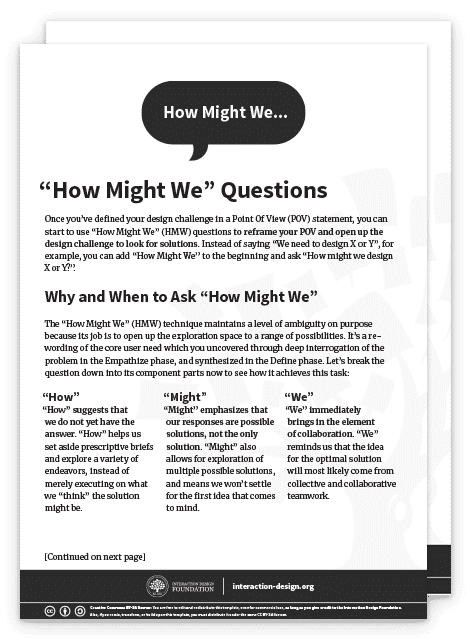

Consider the real-world example from David and Tom Kelley's book, Creative Confidence, to follow the story of the Embrace Warmer. It was a design challenge undertaken by Stanford graduate students to help mitigate neonatal hypothermia, which takes the lives of thousands of infants in developing countries every year.
The students conducted user research to better understand the challenges faced by individuals dealing with the issue of expensive hospital incubators, particularly those living in rural settings with limited physical access to hospitals. This empathetic thinking led them to the "How Might We" statement:
"How Might We create a baby warming device that helps parents in remote villages give their dying infants a chance to survive?"
The Embrace Warmer sleeping bag device, designed in response to the HMW question, delivers the necessary warmth to babies in rural villages at a fraction of the cost of traditional hospital incubators and can be safely stored at home or in a local clinic.
The Embrace Warmer is the product of clever design thinking and the HMW method which allowed the Stanford students to empathize with the villagers to make a positive impact and save precious lives.
© Embrace Innovations. Fair Use.
Although a conventional strategy might have focused on technological efforts to lower incubator costs, the students’ empathetic research uncovered a fundamental issue: mothers were unable or unwilling to leave their villages or their newborns for extended hospital stays. This realization led to a shift in perspective and transformed the incubator into a warming device.
The “How Might We” method is a collaborative process. With key players involved, design teams can initiate the ideation process to empathize with potential users and create multiple ideas for viable design solutions.
© Interaction Design Foundation, CC BY-SA 4.0
When teams involve a diverse group of stakeholders in the HMW process, it allows for key collaboration. With a mix of participants, teams can create comprehensive, user-centered HMW questions reflective of the problem and solution space. This diversity in participation helps discover unique insights and fosters a more holistic approach to problem-solving in the design process.
Key participants should include:
Designers and Researchers: As the primary facilitators of the design process, designers bring expertise in problem-solving, creativity, and user-centered design methodologies. They usually act as facilitators of the HMW process.
Users or User Representatives: Actual users or their representatives make sure HMW questions are grounded in real user needs and experiences.
Cross-Functional Team Members: Members from different teams, such as marketing, development, product management, customer service, etc. provide different perspectives and ideas and a better understanding of the problem.
Subject Matter Experts: Depending on the project, it’s beneficial to include experts in specific fields related to the product or service being designed. These could be technical experts, industry specialists or behavioral scientists, for example.
Stakeholders: Key stakeholders who have an interest in the outcome of the design process, like senior management, investors, or partner organizations.
The limitations of the HMW method in the design process stem from its simplicity and open-ended nature. While HMW is a powerful tool to generate creative ideas and solutions, it can sometimes lack focus and direction. The open-ended questions provide a wide array of ideas, but not all of them may be relevant or doable. This can lead to time wasted on the exploration of ideas that are not good options for the project's overall goals.
Another limitation is that HMW questions can sometimes be too broad, which makes it difficult for designers to find a starting point for ideation. Without specific guidelines or constraints, designers might struggle to come up with ideas that are practical and aligned with the project's objectives.
Furthermore, HMW doesn't inherently prioritize ideas or solutions. Design teams can develop multiple ideas, but without a way to evaluate and prioritize them, deciding which ideas to spend more time on becomes a challenge.
Lastly, HMW questions may not always consider the users’ needs or the context in which a product will be used. This can lead to original outcomes but may not solve the users’ problems or fit well within their environment.
Remember, HMWs are an iterative process, like the overall design thinking process captured above that includes the phases: Empathize, Define, Ideate, Prototype and Test. Although HMWs are a link between the Define and Ideate stages, that does not mean teams can’t revisit or use them in later stages. Similarly, teams must not rely solely on How Might We statements and use other user research methods in harmony with them.
© Interaction Design Foundation, CC BY-SA 4.0
To overcome these limitations, designers should use HMW questions with other tools and methods, such as user research, to guarantee a user-centered approach and focused idea selection for feasible and relevant solutions.
Read more about the How Might We (HMW) method in Define and Frame Your Design Challenge by Creating Your Point Of View and Ask “How Might We” and What is Ideation – and How to Prepare for Ideation Sessions by Rikke Friis Dam and Teo Yu Siang.
Interested in learning more about HMWs and UX design? Enroll in IxDF’s Design Thinking: The Ultimate Guide course.
As HMWs open teams up to think outside the box, you can take your creativity to the next level with Professor Alan Dix’s Master Class, Harness Your Creativity To Design Better Products.
You can learn more about the HMW method in the article Using “How Might We” Questions to Ideate on the Right Problems from the Nielsen Norman Group.
Reference Marty Neumeier’s second Rule of Genius in his Medium post Rule #2: Wish for what you want. Explore more in his book THE 46 RULES OF GENIUS: An innovator’s guide to creativity.
Read Warren Berger’s article on the HMW method via The Secret Phrase Top Innovators Use for more insight.
Interested in more HMW examples? Take a look at these 54 HMW questions.
HMW questions are a great tool in user-centered design as they explore solutions from the users’ perspectives. Stated as open-ended questions, they encourage designers to think creatively about how to meet user needs and solve real-world problems. They are inherently open and flexible as well, so the solutions designers present explore unconventional ideas beyond the obvious.
HMW questions help shift the focus from the designer's assumptions to the users’ needs. By asking creative questions like, "How might we improve our users’ experience with our product?" instead of "What do we think is cool?", designers prioritize the users’ wants and needs in the design process so the developed solutions are the most relevant and valuable to the end user.
HMWs also foster empathy. They require designers and researchers to step into the users' shoes and consider their challenges, needs, and desires. This empathetic approach leads to a better understanding of the user, which is important to genuinely address their problems and create actionable resolutions.
Moreover, the method encourages a collaborative approach to problem-solving. Teams typically use HMWs in brainstorming sessions where team members build on each other's ideas. This agile teamwork can lead to more innovative and user-focused answers, as it combines diverse perspectives and expertise.
Overall, HMWs focus on the user to promote empathy, facilitate team cooperation and support creative problem-solving, all of which are essential to design products which truly meet the needs of the users.
Learn how to think creatively and apply techniques, like HMWs and their variations, to get reasonable creative ideas when we need them.
In the course Harness Your Creativity To Design Better Products, HCI expert, Professor Alan Dix walks you through several ideation methods―both for generating new ideas and for developing your ideas further.
Some books that cover the “How Might We” and other design thinking methods include:
How Might We Champion Design Thinking in Your Organization?: A PRAKTIKEL Guide by Dan Buchner from FriesenPress, 2021.
The guide serves as a rich source of practical ideas meant to motivate, instill confidence, and help others recognize the value of design thinking. The author includes ideas from years of hands-on experience involving trial and error and collaboration with individuals across diverse organizations. The book is a friendly guide which shares stories, observations, aha moments, and HMWs.
The Art of Innovation: Lessons in Creativity from IDEO, America's Leading Design Firm by Tom Kelley with John Littman by Currency, 2001.
This book offers a peek into the practices and strategies of IDEO, which is renowned for its innovative use of design thinking methodologies, including HMW.
Change by Design: How Design Thinking Transforms Organizations and Inspires Innovation by Tim Brown, Chairman and former CEO of IDEO, by HarperBusiness, 2009.
In the book, Tim Brown provides a comprehensive overview of design thinking, a process in which HMW questions play a crucial role.
Some interesting research surrounding HMW and other user research methods includes:
Fabri, M. 2015. Thinking with a New Purpose: Lessons Learned from Teaching Design Thinking Skills to Creative Technology Students. In Design, User Experience, and Usability: Design Discourse, edited by A. Marcus, 9186: Lecture Notes in Computer Science. Cham: Springer.
Siemon, Dominik, Felix Becker, and Susanne Robra-Bissantz. 2018. How Might We? From Design Challenges to Business Innovation. 4: 96–110.
Uebernickel, Falk, Matthias Herterich, and Jennifer Hehn. 2018. Design Thinking Methods for Service Innovation - A Delphi Study.
Teams can significantly reduce the risk of bias in HMW questions with these strategies:
Diverse Team: Include individuals with different backgrounds, experiences, and perspectives on the team. This diversity helps to challenge assumptions and bring a variety of viewpoints to the table, reducing the risk of a singular, biased perspective.
User Research: Ground HMW questions in thorough user research. Understanding users’ needs, behaviors, and contexts through methods like interviews, surveys, and observation helps base questions on real-world data rather than personal assumptions.
Assess HMWs: Regularly review, refine, and iterate HMW questions. Encourage team members to identify and question any implicit biases within the questions.
External Feedback: Seek feedback on HMW questions from people outside of the design team, especially those who represent the end users. This external perspective can highlight unseen biases and assumptions.
Bias Training: Educate the team and relevant stakeholders about common cognitive biases (such as confirmation bias, anchoring, or groupthink) to increase awareness and foster a more critical approach to formulating HMW questions.
Structured Brainstorming: Use structured brainstorming methods to give each team member an equal opportunity to contribute. Techniques like brainwriting can prevent dominant voices from overshadowing others for a more balanced set of perspectives.
We can use HMWs with various brainstorming techniques to progress creativity and idea generation in design processes. The combination results in diverse and comprehensive solutions.
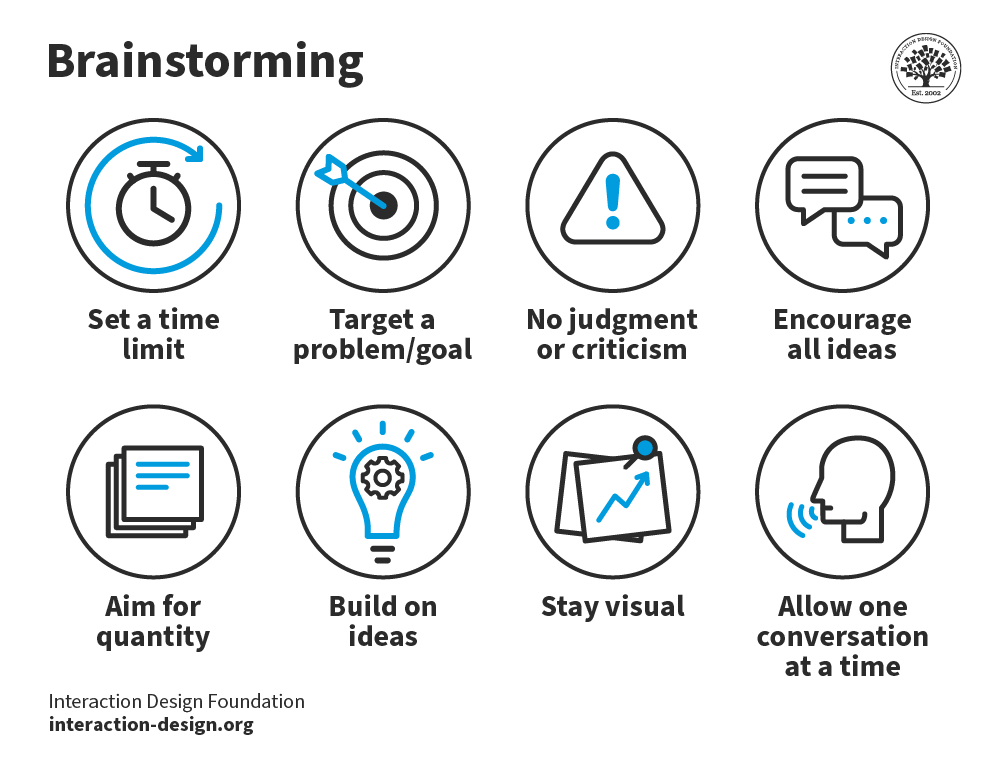 You can apply the brainstorming guidelines pictured above to any ideation session, including HMWs.
You can apply the brainstorming guidelines pictured above to any ideation session, including HMWs.
© Interaction Design Foundation, CC BY-SA 4.0
For example, brainwriting begins with HMW questions to pinpoint focus areas, followed by team members individually writing down ideas. This benefits those who prefer writing over speaking. Additionally, mind mapping with HMW questions visually explores problem aspects and interconnections for holistic solutions.
The SCAMPER technique (Substitute, Combine, Adapt, Modify, Put to another use, Eliminate, Reverse) pairs with HMW questions, prompting teams to rethink existing products or processes. Furthermore, the Six Thinking Hats method by Edward de Bono, representing different perspectives, integrates with HMW questions for a multifaceted exploration. As does Starbursting, a technique that generates questions instead of answers and works alongside HMW questions to deeply understand problems.
Finally, HMW questions also assist in crafting storyboards and visualizing user journeys, thereby centering the ideation session on human experiences. The combination of HMW questions with these brainstorming methods enables teams to take advantage of each technique for more innovative, well-rounded and human-centered design solutions.
Yes, teams can effectively use HMW questions in remote or virtual team settings. The adaptability of HMW questions makes them perfect for digital collaboration. Explore some helpful strategies for a remote context:
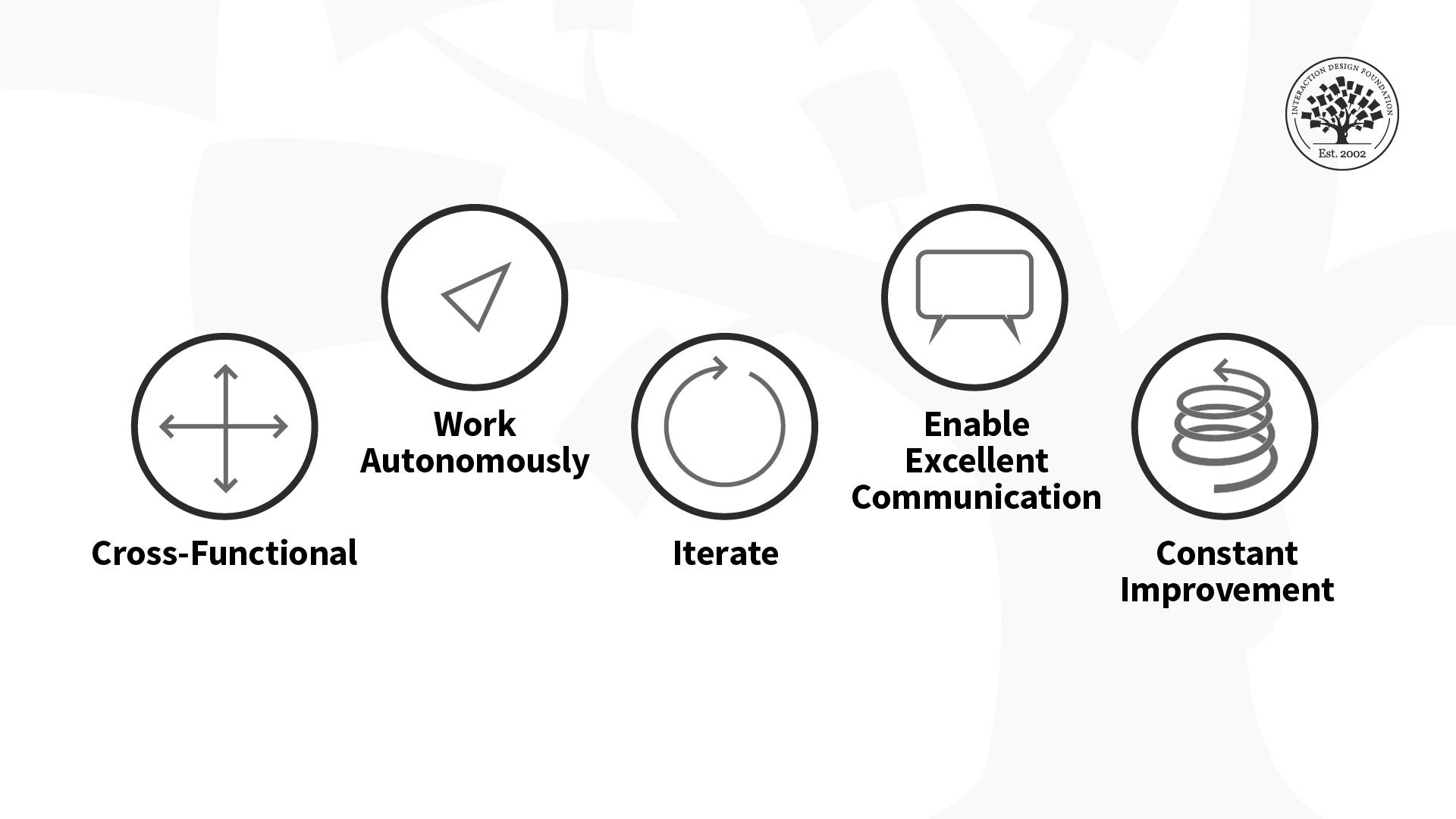 Follow the strategies to incorporate the HMW technique in a virtual environment. Strive for agile teamwork across teams with clear communication, and don’t forget to iterate!
Follow the strategies to incorporate the HMW technique in a virtual environment. Strive for agile teamwork across teams with clear communication, and don’t forget to iterate!
© Interaction Design Foundation, CC BY-SA 4.0
Digital Collaboration Tools: Use digital tools such as online whiteboards (e.g., Miro, Figma) and collaborative document platforms (e.g., Google Docs) to brainstorm and document HMW questions. These tools enable real-time collaboration and idea sharing.
Structured Virtual Meetings with Breakout Sessions: Organize structured virtual meetings or workshops dedicated to HMW brainstorming. Clearly outline the agenda and objectives beforehand and ensure everyone understands the HMW process. In larger teams, use breakout sessions to facilitate smaller group discussions, to make sure all team members participate to be able to generate more diverse ideas.
Asynchronous Brainstorming and Communication: Recognize the potential for asynchronous brainstorming, allowing team members in different time zones to contribute HMW questions and ideas at their convenience. Do this by maintaining clear and regular communication so everyone is aligned on the goals and context of the HMW questions. Use channels like Slack, Teams, or email for updates and ongoing discussions, leading to more thoughtful and considered contributions.
Facilitation and Moderation: Have a dedicated facilitator to guide the HMW sessions. It’s important the conversation stays on track and all voices are heard, especially in a virtual setting where it’s easy for some participants to become passive.
Feedback and Iteration: Encourage and incorporate feedback on the HMW questions and iterate on them as necessary. Do this via follow-up meetings or shared digital platforms.
HMW questions smoothly integrate with various design thinking tools, boosting their effectiveness.
Empathy maps capture users' thoughts, feelings, experiences, needs, etc., and they inform HMW questions to address specific user needs.
After the development of user personas, designers tailor HMW questions to meet their distinct needs, goals and pain points, enhancing question relevance.
Alongside user journey maps, HMW questions focus on particular journey stages and aid in pinpointing and resolving additional pain points while improving the user experience throughout.
During prototype development and testing, HMW questions concentrate on user-specific needs or problems and assist in hypothesis formulation about user behavior and preferences.
Integrating HMW questions with these design thinking tools ensures a consistent human-centered approach, leading to more targeted, creative and efficient resolutions that align closely with user needs.
Learn more about the tools designers need in their UX toolbox to optimize the design thinking process with Susan Weinschenk and Guthrie Weinschenk.
Watch the Master Class, How to Build Your UX Toolbox, today!
Adapt HMWs to specific industries or projects by tailoring them to unique challenges and contexts:
Research industry challenges, terminologies, regulatory environments and user behaviors to create relevant HMW questions.
Develop user personas for the industry’s target audience and use them to direct HMW questions to their specific needs and wants.
Integrate constraints like regulatory compliance and technical limitations into HMW questions.
Aim to align HMW questions with project objectives, particularly for innovative solutions within the industry context.
Involve industry experts for depth and accuracy to ground HMWs in real-world knowledge.
Include technical specifics in HMW questions for technically complex industries to improve actionable solutions.
Continually adapt and refine HMW questions as the project evolves and new insights are gained.
By customizing HMW questions, they more effectively elicit targeted, interesting and workable solutions in a creative process relevant to industry realities and project goals.
For advanced or complex design projects, HMW questions evolve to meet greater complexity:
Increased Specificity: HMW questions become more specific, focusing on particular challenges and delving into nuanced design areas.
Integration of Technical and Business Constraints: These questions incorporate technical and business considerations, like scalability and alignment with business strategies.
User-Centric but Holistic: HMW maintains a user-centric approach but also considers the entire ecosystem, including supply chains and environmental impact.
Iterative Refinement: HMW questions undergo iterative refinement to adjust to new information as the project progresses.
Cross-Disciplinary Input: They draw on diverse fields such as technology, business and psychology for various perspectives.
Emphasis on Feasibility and Viability: HMW questions balance creative ideation with realistic implementation and sustainability considerations.
Risk and Future-Proofing: HMWs include risk management and future-proofing to assess how design decisions might play out in future scenarios.
In summary, as design projects and their goals grow in complexity, HMW questions adapt to become more targeted, integrated, iterative and forward-looking.
HMWs seamlessly integrate into agile design methodologies and complement their flexible and user-centered nature.
During sprint planning sessions, teams use HMW questions to define goals and focus. These questions pose challenges and objectives, foster creative problem-solving and center users’ needs. They also aid the development of user stories by summarizing those needs and problems, which are then later put to use in designs that focus on real user requirements.
In daily standups and iterative reviews, HMW questions enable teams to reassess their approaches based on new findings and feedback—demonstrating the agile principle of “embrace change.” They also act as catalysts in cooperative brainstorming sessions, which often spark user-centric and novel ideas.
At the end of each sprint, teams use HMW questions in retrospectives to reflect on learned lessons and identify areas for process and outcome improvements. This practice supports the agile methodology’s goal of “continuous improvement.”
When teams incorporate HMW questions into various stages of the agile design process, a sustained focus on user needs, creativity and adaptive responses to new insights and changes emerges and embodies the core principles of agile methodologies.
Enroll in the IxDF course, Agile Methods for UX Design, with author and agile expert Laura Klein.
Remember, the more you learn about design, the more you make yourself valuable.
Improve your UX / UI Design skills and grow your career! Join IxDF now!
You earned your gift with a perfect score! Let us send it to you.
We've emailed your gift to name@email.com.
Improve your UX / UI Design skills and grow your career! Join IxDF now!
Here's the entire UX literature on How Might We (HMW) by the Interaction Design Foundation, collated in one place:
Take a deep dive into How Might We (HMW) with our course Design Thinking: The Ultimate Guide .
Master complex skills effortlessly with proven best practices and toolkits directly from the world's top design experts. Meet your experts for this course:
Don Norman: Father of User Experience (UX) Design, author of the legendary book “The Design of Everyday Things,” and co-founder of the Nielsen Norman Group.
Alan Dix: Author of the bestselling book “Human-Computer Interaction” and Director of the Computational Foundry at Swansea University.
Mike Rohde: Experience and Interface Designer, author of the bestselling “The Sketchnote Handbook.”


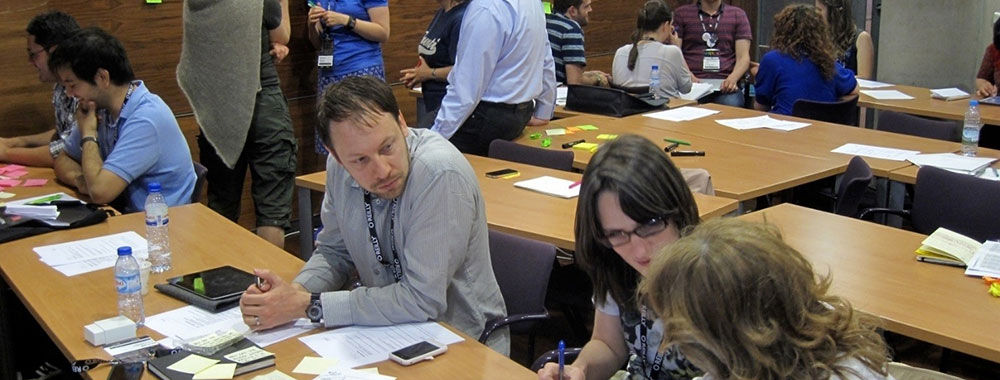
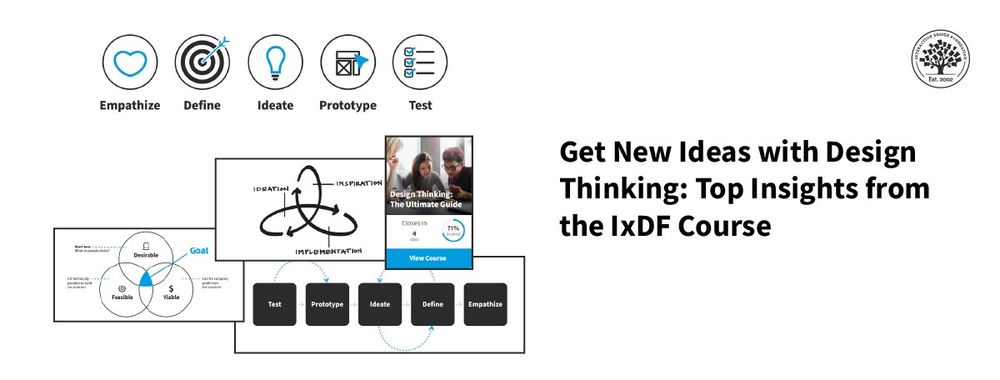
We believe in Open Access and the democratization of knowledge. Unfortunately, world-class educational materials such as this page are normally hidden behind paywalls or in expensive textbooks.
If you want this to change, , link to us, or join us to help us democratize design knowledge!
